HRMT20024 Essay: Key Challenges in Attracting and Retaining Staff
VerifiedAdded on 2023/06/03
|12
|3890
|153
Essay
AI Summary
This essay delves into the critical challenges of attracting and retaining staff within the manufacturing sector, focusing on five key themes of human resources: HR Planning, Recruitment and Selection, Employee Relation Challenges, Performance Management, and Motivation, Reward, and Compensation. It highlights the impact of rapid technological development, the need for HR departments to adapt to changing employment and financial requirements, and the ethical considerations involved in maintaining companies for the benefit of both the firms and society. The essay further explores the importance of HRD in enhancing employee capabilities, the significance of well-chosen and qualified staff in recruitment, and the issues related to an aging workforce and skills shortages in the manufacturing industry. Finally, it discusses the role of performance management in achieving organizational targets and the importance of employee motivation and reward systems in retaining skilled workers.
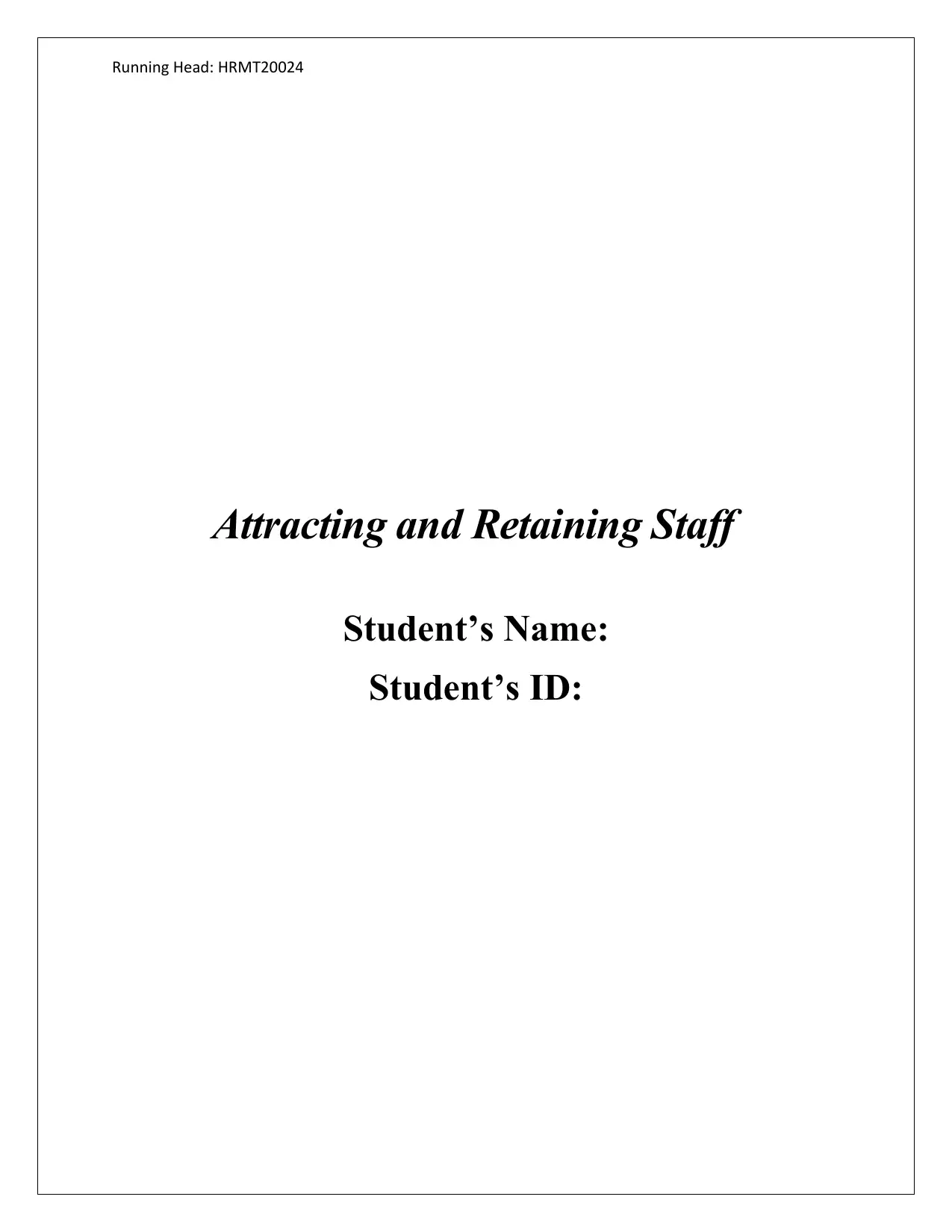
Running Head: HRMT20024
Attracting and Retaining Staff
Student’s Name:
Student’s ID:
Attracting and Retaining Staff
Student’s Name:
Student’s ID:
Paraphrase This Document
Need a fresh take? Get an instant paraphrase of this document with our AI Paraphraser
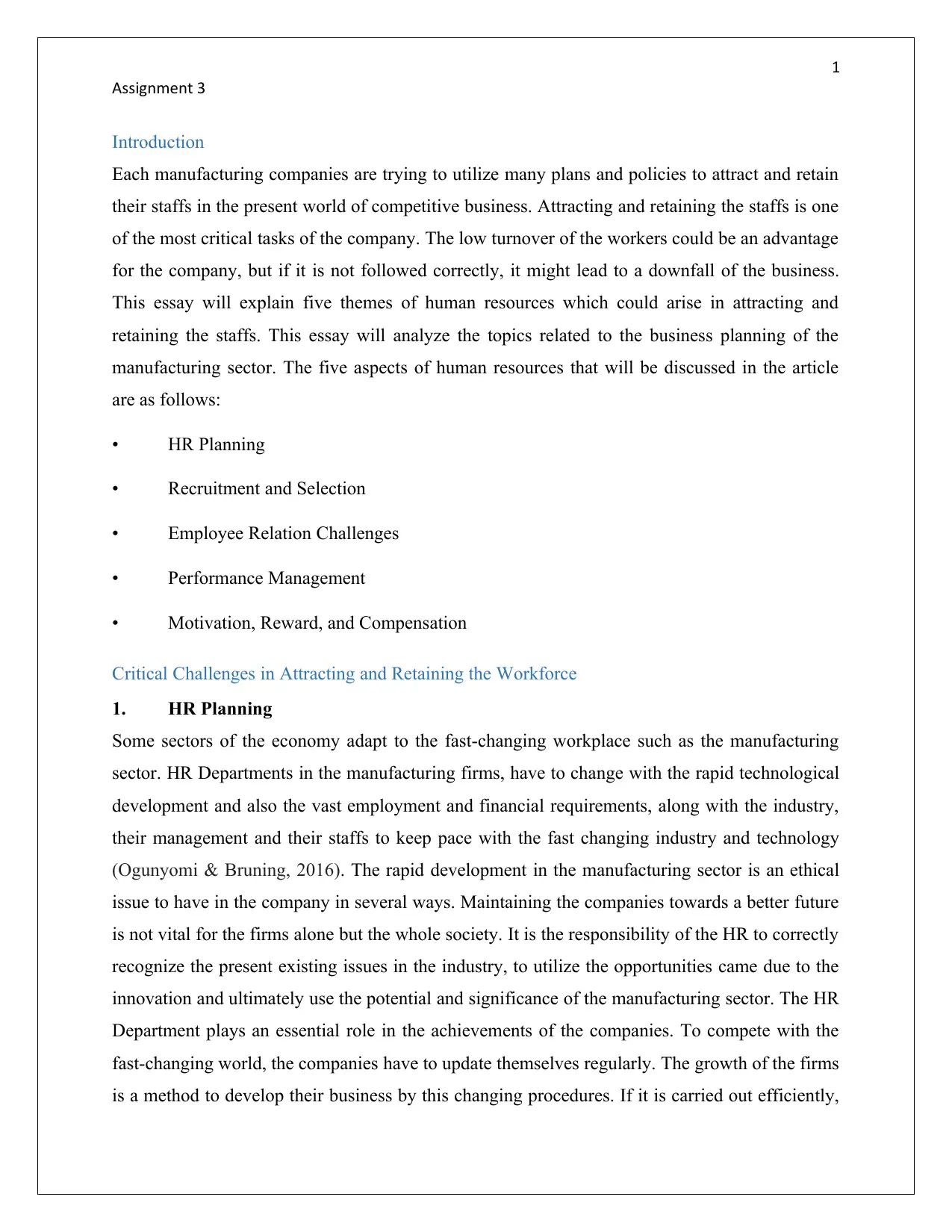
1
Assignment 3
Introduction
Each manufacturing companies are trying to utilize many plans and policies to attract and retain
their staffs in the present world of competitive business. Attracting and retaining the staffs is one
of the most critical tasks of the company. The low turnover of the workers could be an advantage
for the company, but if it is not followed correctly, it might lead to a downfall of the business.
This essay will explain five themes of human resources which could arise in attracting and
retaining the staffs. This essay will analyze the topics related to the business planning of the
manufacturing sector. The five aspects of human resources that will be discussed in the article
are as follows:
• HR Planning
• Recruitment and Selection
• Employee Relation Challenges
• Performance Management
• Motivation, Reward, and Compensation
Critical Challenges in Attracting and Retaining the Workforce
1. HR Planning
Some sectors of the economy adapt to the fast-changing workplace such as the manufacturing
sector. HR Departments in the manufacturing firms, have to change with the rapid technological
development and also the vast employment and financial requirements, along with the industry,
their management and their staffs to keep pace with the fast changing industry and technology
(Ogunyomi & Bruning, 2016). The rapid development in the manufacturing sector is an ethical
issue to have in the company in several ways. Maintaining the companies towards a better future
is not vital for the firms alone but the whole society. It is the responsibility of the HR to correctly
recognize the present existing issues in the industry, to utilize the opportunities came due to the
innovation and ultimately use the potential and significance of the manufacturing sector. The HR
Department plays an essential role in the achievements of the companies. To compete with the
fast-changing world, the companies have to update themselves regularly. The growth of the firms
is a method to develop their business by this changing procedures. If it is carried out efficiently,
Assignment 3
Introduction
Each manufacturing companies are trying to utilize many plans and policies to attract and retain
their staffs in the present world of competitive business. Attracting and retaining the staffs is one
of the most critical tasks of the company. The low turnover of the workers could be an advantage
for the company, but if it is not followed correctly, it might lead to a downfall of the business.
This essay will explain five themes of human resources which could arise in attracting and
retaining the staffs. This essay will analyze the topics related to the business planning of the
manufacturing sector. The five aspects of human resources that will be discussed in the article
are as follows:
• HR Planning
• Recruitment and Selection
• Employee Relation Challenges
• Performance Management
• Motivation, Reward, and Compensation
Critical Challenges in Attracting and Retaining the Workforce
1. HR Planning
Some sectors of the economy adapt to the fast-changing workplace such as the manufacturing
sector. HR Departments in the manufacturing firms, have to change with the rapid technological
development and also the vast employment and financial requirements, along with the industry,
their management and their staffs to keep pace with the fast changing industry and technology
(Ogunyomi & Bruning, 2016). The rapid development in the manufacturing sector is an ethical
issue to have in the company in several ways. Maintaining the companies towards a better future
is not vital for the firms alone but the whole society. It is the responsibility of the HR to correctly
recognize the present existing issues in the industry, to utilize the opportunities came due to the
innovation and ultimately use the potential and significance of the manufacturing sector. The HR
Department plays an essential role in the achievements of the companies. To compete with the
fast-changing world, the companies have to update themselves regularly. The growth of the firms
is a method to develop their business by this changing procedures. If it is carried out efficiently,
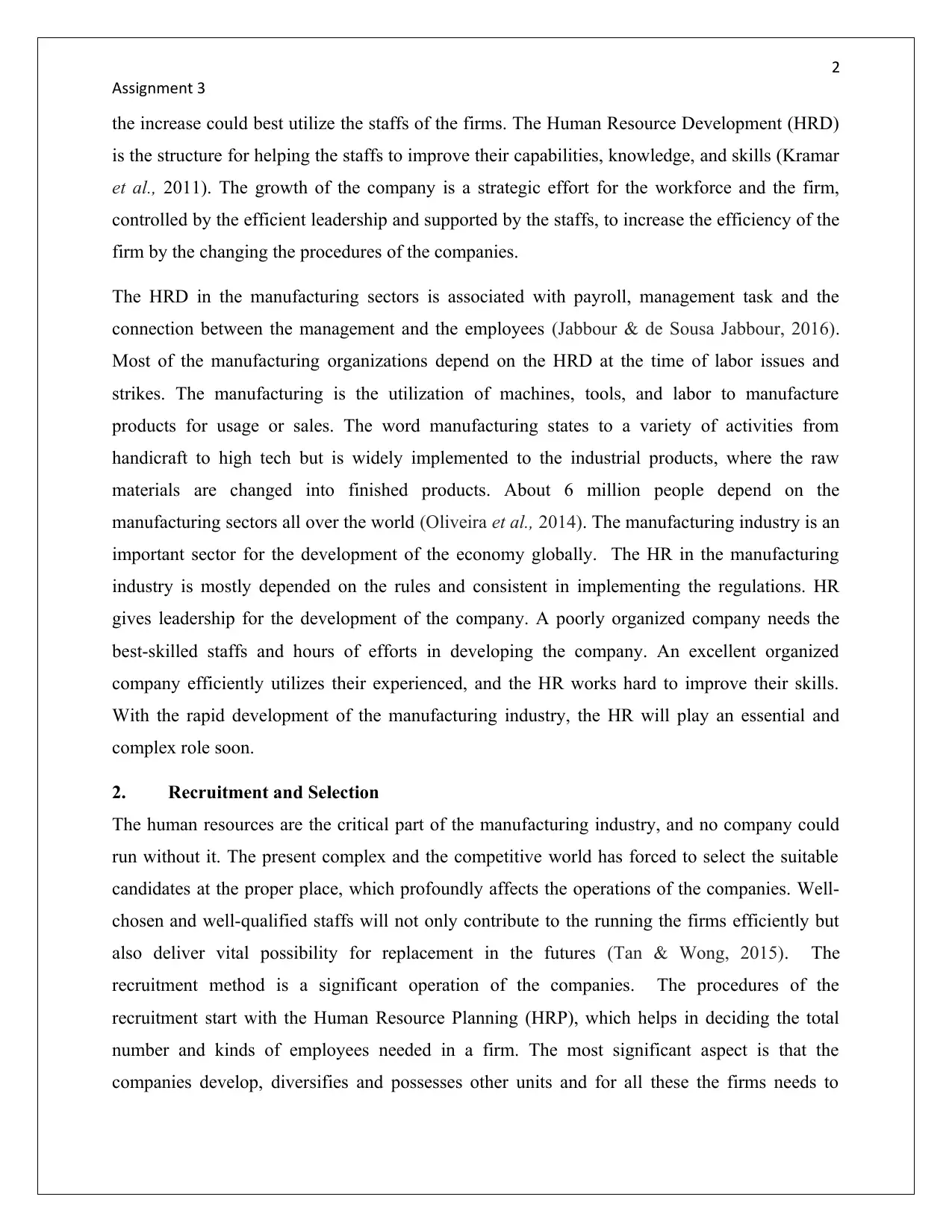
2
Assignment 3
the increase could best utilize the staffs of the firms. The Human Resource Development (HRD)
is the structure for helping the staffs to improve their capabilities, knowledge, and skills (Kramar
et al., 2011). The growth of the company is a strategic effort for the workforce and the firm,
controlled by the efficient leadership and supported by the staffs, to increase the efficiency of the
firm by the changing the procedures of the companies.
The HRD in the manufacturing sectors is associated with payroll, management task and the
connection between the management and the employees (Jabbour & de Sousa Jabbour, 2016).
Most of the manufacturing organizations depend on the HRD at the time of labor issues and
strikes. The manufacturing is the utilization of machines, tools, and labor to manufacture
products for usage or sales. The word manufacturing states to a variety of activities from
handicraft to high tech but is widely implemented to the industrial products, where the raw
materials are changed into finished products. About 6 million people depend on the
manufacturing sectors all over the world (Oliveira et al., 2014). The manufacturing industry is an
important sector for the development of the economy globally. The HR in the manufacturing
industry is mostly depended on the rules and consistent in implementing the regulations. HR
gives leadership for the development of the company. A poorly organized company needs the
best-skilled staffs and hours of efforts in developing the company. An excellent organized
company efficiently utilizes their experienced, and the HR works hard to improve their skills.
With the rapid development of the manufacturing industry, the HR will play an essential and
complex role soon.
2. Recruitment and Selection
The human resources are the critical part of the manufacturing industry, and no company could
run without it. The present complex and the competitive world has forced to select the suitable
candidates at the proper place, which profoundly affects the operations of the companies. Well-
chosen and well-qualified staffs will not only contribute to the running the firms efficiently but
also deliver vital possibility for replacement in the futures (Tan & Wong, 2015). The
recruitment method is a significant operation of the companies. The procedures of the
recruitment start with the Human Resource Planning (HRP), which helps in deciding the total
number and kinds of employees needed in a firm. The most significant aspect is that the
companies develop, diversifies and possesses other units and for all these the firms needs to
Assignment 3
the increase could best utilize the staffs of the firms. The Human Resource Development (HRD)
is the structure for helping the staffs to improve their capabilities, knowledge, and skills (Kramar
et al., 2011). The growth of the company is a strategic effort for the workforce and the firm,
controlled by the efficient leadership and supported by the staffs, to increase the efficiency of the
firm by the changing the procedures of the companies.
The HRD in the manufacturing sectors is associated with payroll, management task and the
connection between the management and the employees (Jabbour & de Sousa Jabbour, 2016).
Most of the manufacturing organizations depend on the HRD at the time of labor issues and
strikes. The manufacturing is the utilization of machines, tools, and labor to manufacture
products for usage or sales. The word manufacturing states to a variety of activities from
handicraft to high tech but is widely implemented to the industrial products, where the raw
materials are changed into finished products. About 6 million people depend on the
manufacturing sectors all over the world (Oliveira et al., 2014). The manufacturing industry is an
important sector for the development of the economy globally. The HR in the manufacturing
industry is mostly depended on the rules and consistent in implementing the regulations. HR
gives leadership for the development of the company. A poorly organized company needs the
best-skilled staffs and hours of efforts in developing the company. An excellent organized
company efficiently utilizes their experienced, and the HR works hard to improve their skills.
With the rapid development of the manufacturing industry, the HR will play an essential and
complex role soon.
2. Recruitment and Selection
The human resources are the critical part of the manufacturing industry, and no company could
run without it. The present complex and the competitive world has forced to select the suitable
candidates at the proper place, which profoundly affects the operations of the companies. Well-
chosen and well-qualified staffs will not only contribute to the running the firms efficiently but
also deliver vital possibility for replacement in the futures (Tan & Wong, 2015). The
recruitment method is a significant operation of the companies. The procedures of the
recruitment start with the Human Resource Planning (HRP), which helps in deciding the total
number and kinds of employees needed in a firm. The most significant aspect is that the
companies develop, diversifies and possesses other units and for all these the firms needs to
⊘ This is a preview!⊘
Do you want full access?
Subscribe today to unlock all pages.

Trusted by 1+ million students worldwide
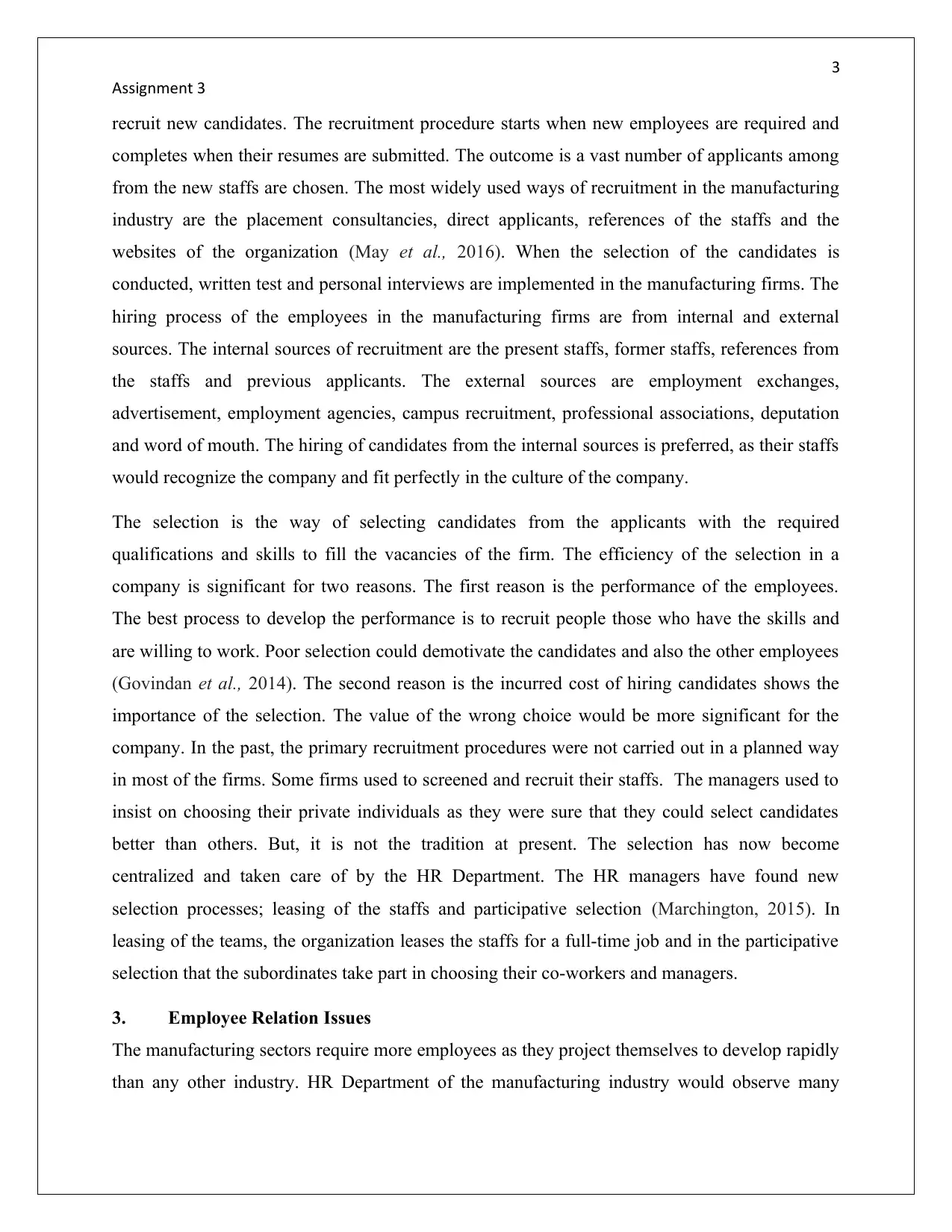
3
Assignment 3
recruit new candidates. The recruitment procedure starts when new employees are required and
completes when their resumes are submitted. The outcome is a vast number of applicants among
from the new staffs are chosen. The most widely used ways of recruitment in the manufacturing
industry are the placement consultancies, direct applicants, references of the staffs and the
websites of the organization (May et al., 2016). When the selection of the candidates is
conducted, written test and personal interviews are implemented in the manufacturing firms. The
hiring process of the employees in the manufacturing firms are from internal and external
sources. The internal sources of recruitment are the present staffs, former staffs, references from
the staffs and previous applicants. The external sources are employment exchanges,
advertisement, employment agencies, campus recruitment, professional associations, deputation
and word of mouth. The hiring of candidates from the internal sources is preferred, as their staffs
would recognize the company and fit perfectly in the culture of the company.
The selection is the way of selecting candidates from the applicants with the required
qualifications and skills to fill the vacancies of the firm. The efficiency of the selection in a
company is significant for two reasons. The first reason is the performance of the employees.
The best process to develop the performance is to recruit people those who have the skills and
are willing to work. Poor selection could demotivate the candidates and also the other employees
(Govindan et al., 2014). The second reason is the incurred cost of hiring candidates shows the
importance of the selection. The value of the wrong choice would be more significant for the
company. In the past, the primary recruitment procedures were not carried out in a planned way
in most of the firms. Some firms used to screened and recruit their staffs. The managers used to
insist on choosing their private individuals as they were sure that they could select candidates
better than others. But, it is not the tradition at present. The selection has now become
centralized and taken care of by the HR Department. The HR managers have found new
selection processes; leasing of the staffs and participative selection (Marchington, 2015). In
leasing of the teams, the organization leases the staffs for a full-time job and in the participative
selection that the subordinates take part in choosing their co-workers and managers.
3. Employee Relation Issues
The manufacturing sectors require more employees as they project themselves to develop rapidly
than any other industry. HR Department of the manufacturing industry would observe many
Assignment 3
recruit new candidates. The recruitment procedure starts when new employees are required and
completes when their resumes are submitted. The outcome is a vast number of applicants among
from the new staffs are chosen. The most widely used ways of recruitment in the manufacturing
industry are the placement consultancies, direct applicants, references of the staffs and the
websites of the organization (May et al., 2016). When the selection of the candidates is
conducted, written test and personal interviews are implemented in the manufacturing firms. The
hiring process of the employees in the manufacturing firms are from internal and external
sources. The internal sources of recruitment are the present staffs, former staffs, references from
the staffs and previous applicants. The external sources are employment exchanges,
advertisement, employment agencies, campus recruitment, professional associations, deputation
and word of mouth. The hiring of candidates from the internal sources is preferred, as their staffs
would recognize the company and fit perfectly in the culture of the company.
The selection is the way of selecting candidates from the applicants with the required
qualifications and skills to fill the vacancies of the firm. The efficiency of the selection in a
company is significant for two reasons. The first reason is the performance of the employees.
The best process to develop the performance is to recruit people those who have the skills and
are willing to work. Poor selection could demotivate the candidates and also the other employees
(Govindan et al., 2014). The second reason is the incurred cost of hiring candidates shows the
importance of the selection. The value of the wrong choice would be more significant for the
company. In the past, the primary recruitment procedures were not carried out in a planned way
in most of the firms. Some firms used to screened and recruit their staffs. The managers used to
insist on choosing their private individuals as they were sure that they could select candidates
better than others. But, it is not the tradition at present. The selection has now become
centralized and taken care of by the HR Department. The HR managers have found new
selection processes; leasing of the staffs and participative selection (Marchington, 2015). In
leasing of the teams, the organization leases the staffs for a full-time job and in the participative
selection that the subordinates take part in choosing their co-workers and managers.
3. Employee Relation Issues
The manufacturing sectors require more employees as they project themselves to develop rapidly
than any other industry. HR Department of the manufacturing industry would observe many
Paraphrase This Document
Need a fresh take? Get an instant paraphrase of this document with our AI Paraphraser
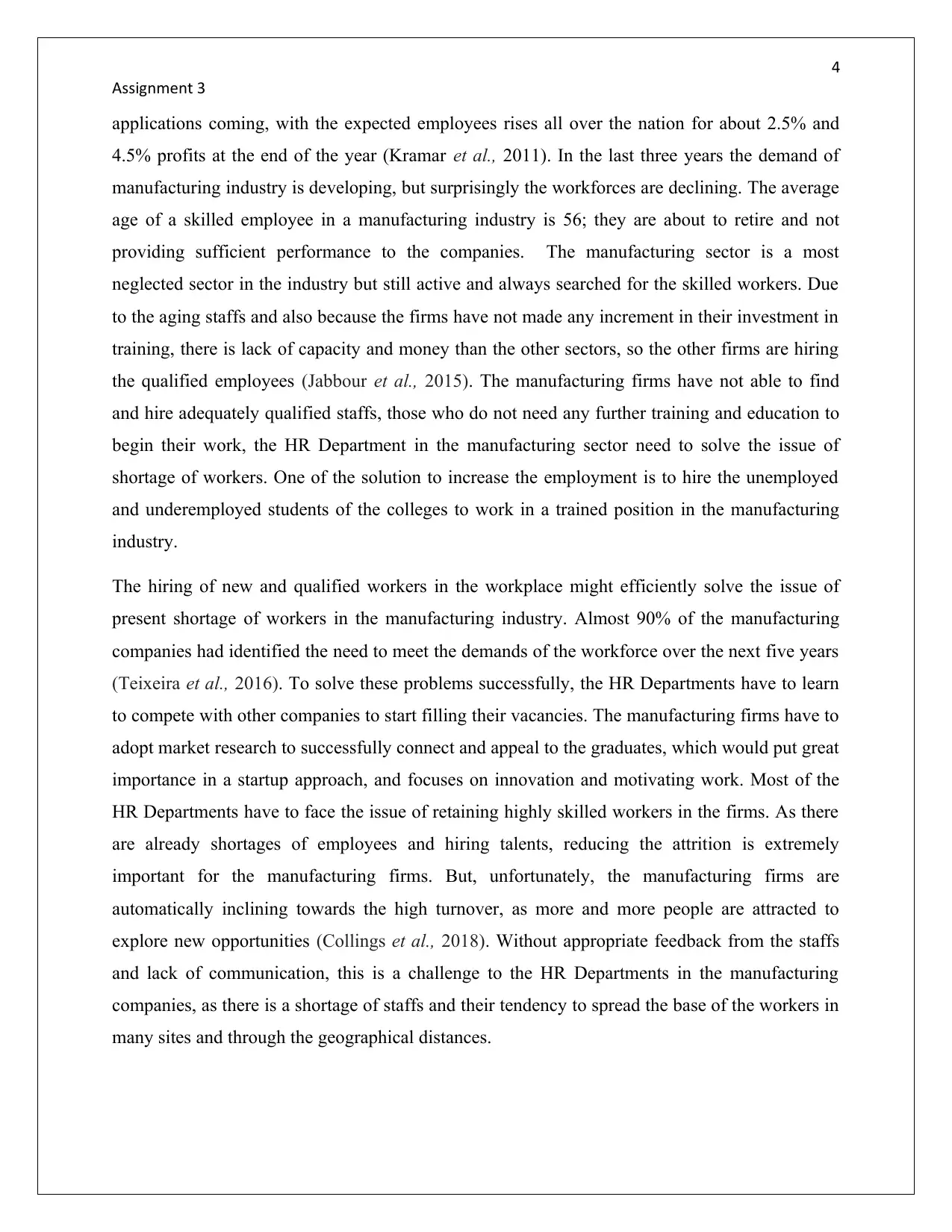
4
Assignment 3
applications coming, with the expected employees rises all over the nation for about 2.5% and
4.5% profits at the end of the year (Kramar et al., 2011). In the last three years the demand of
manufacturing industry is developing, but surprisingly the workforces are declining. The average
age of a skilled employee in a manufacturing industry is 56; they are about to retire and not
providing sufficient performance to the companies. The manufacturing sector is a most
neglected sector in the industry but still active and always searched for the skilled workers. Due
to the aging staffs and also because the firms have not made any increment in their investment in
training, there is lack of capacity and money than the other sectors, so the other firms are hiring
the qualified employees (Jabbour et al., 2015). The manufacturing firms have not able to find
and hire adequately qualified staffs, those who do not need any further training and education to
begin their work, the HR Department in the manufacturing sector need to solve the issue of
shortage of workers. One of the solution to increase the employment is to hire the unemployed
and underemployed students of the colleges to work in a trained position in the manufacturing
industry.
The hiring of new and qualified workers in the workplace might efficiently solve the issue of
present shortage of workers in the manufacturing industry. Almost 90% of the manufacturing
companies had identified the need to meet the demands of the workforce over the next five years
(Teixeira et al., 2016). To solve these problems successfully, the HR Departments have to learn
to compete with other companies to start filling their vacancies. The manufacturing firms have to
adopt market research to successfully connect and appeal to the graduates, which would put great
importance in a startup approach, and focuses on innovation and motivating work. Most of the
HR Departments have to face the issue of retaining highly skilled workers in the firms. As there
are already shortages of employees and hiring talents, reducing the attrition is extremely
important for the manufacturing firms. But, unfortunately, the manufacturing firms are
automatically inclining towards the high turnover, as more and more people are attracted to
explore new opportunities (Collings et al., 2018). Without appropriate feedback from the staffs
and lack of communication, this is a challenge to the HR Departments in the manufacturing
companies, as there is a shortage of staffs and their tendency to spread the base of the workers in
many sites and through the geographical distances.
Assignment 3
applications coming, with the expected employees rises all over the nation for about 2.5% and
4.5% profits at the end of the year (Kramar et al., 2011). In the last three years the demand of
manufacturing industry is developing, but surprisingly the workforces are declining. The average
age of a skilled employee in a manufacturing industry is 56; they are about to retire and not
providing sufficient performance to the companies. The manufacturing sector is a most
neglected sector in the industry but still active and always searched for the skilled workers. Due
to the aging staffs and also because the firms have not made any increment in their investment in
training, there is lack of capacity and money than the other sectors, so the other firms are hiring
the qualified employees (Jabbour et al., 2015). The manufacturing firms have not able to find
and hire adequately qualified staffs, those who do not need any further training and education to
begin their work, the HR Department in the manufacturing sector need to solve the issue of
shortage of workers. One of the solution to increase the employment is to hire the unemployed
and underemployed students of the colleges to work in a trained position in the manufacturing
industry.
The hiring of new and qualified workers in the workplace might efficiently solve the issue of
present shortage of workers in the manufacturing industry. Almost 90% of the manufacturing
companies had identified the need to meet the demands of the workforce over the next five years
(Teixeira et al., 2016). To solve these problems successfully, the HR Departments have to learn
to compete with other companies to start filling their vacancies. The manufacturing firms have to
adopt market research to successfully connect and appeal to the graduates, which would put great
importance in a startup approach, and focuses on innovation and motivating work. Most of the
HR Departments have to face the issue of retaining highly skilled workers in the firms. As there
are already shortages of employees and hiring talents, reducing the attrition is extremely
important for the manufacturing firms. But, unfortunately, the manufacturing firms are
automatically inclining towards the high turnover, as more and more people are attracted to
explore new opportunities (Collings et al., 2018). Without appropriate feedback from the staffs
and lack of communication, this is a challenge to the HR Departments in the manufacturing
companies, as there is a shortage of staffs and their tendency to spread the base of the workers in
many sites and through the geographical distances.
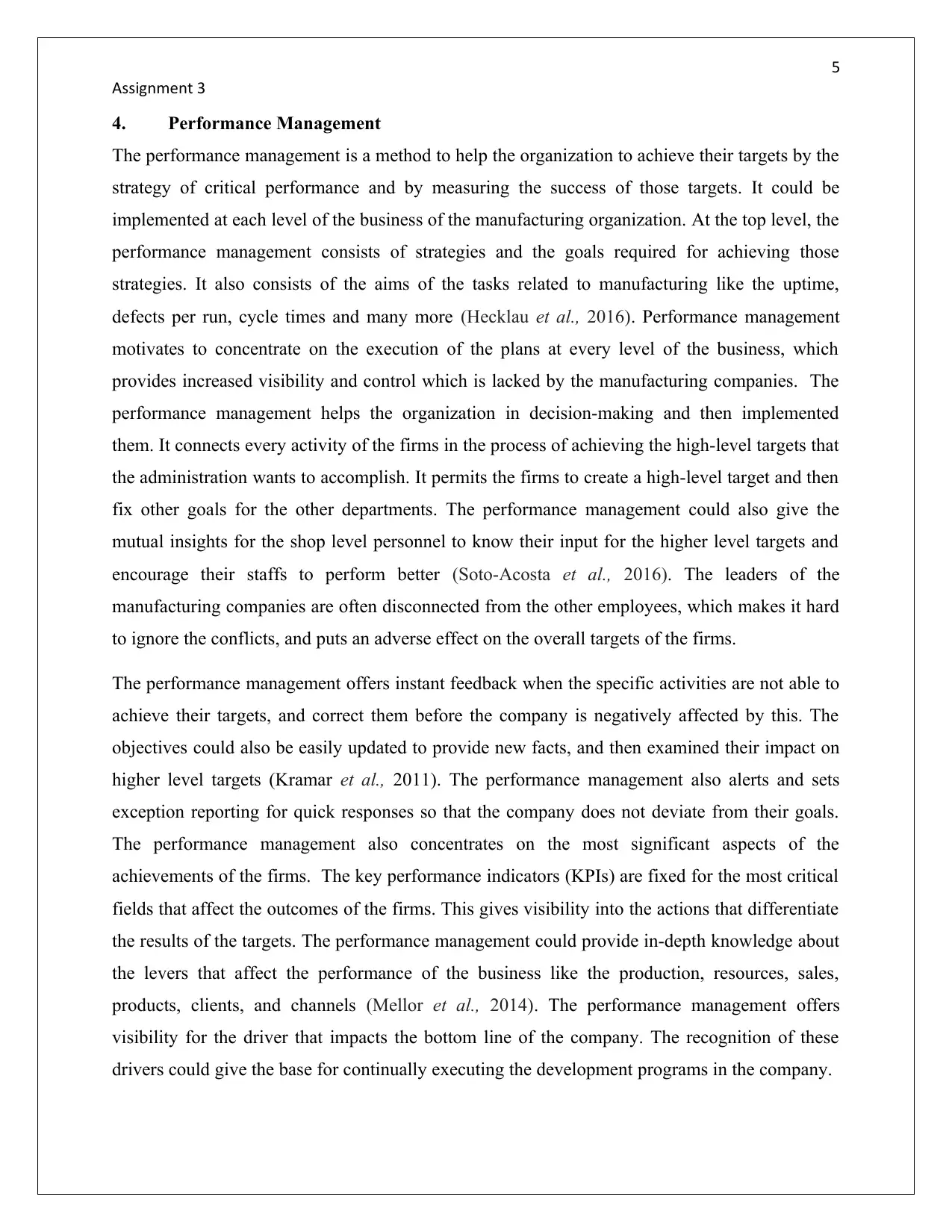
5
Assignment 3
4. Performance Management
The performance management is a method to help the organization to achieve their targets by the
strategy of critical performance and by measuring the success of those targets. It could be
implemented at each level of the business of the manufacturing organization. At the top level, the
performance management consists of strategies and the goals required for achieving those
strategies. It also consists of the aims of the tasks related to manufacturing like the uptime,
defects per run, cycle times and many more (Hecklau et al., 2016). Performance management
motivates to concentrate on the execution of the plans at every level of the business, which
provides increased visibility and control which is lacked by the manufacturing companies. The
performance management helps the organization in decision-making and then implemented
them. It connects every activity of the firms in the process of achieving the high-level targets that
the administration wants to accomplish. It permits the firms to create a high-level target and then
fix other goals for the other departments. The performance management could also give the
mutual insights for the shop level personnel to know their input for the higher level targets and
encourage their staffs to perform better (Soto-Acosta et al., 2016). The leaders of the
manufacturing companies are often disconnected from the other employees, which makes it hard
to ignore the conflicts, and puts an adverse effect on the overall targets of the firms.
The performance management offers instant feedback when the specific activities are not able to
achieve their targets, and correct them before the company is negatively affected by this. The
objectives could also be easily updated to provide new facts, and then examined their impact on
higher level targets (Kramar et al., 2011). The performance management also alerts and sets
exception reporting for quick responses so that the company does not deviate from their goals.
The performance management also concentrates on the most significant aspects of the
achievements of the firms. The key performance indicators (KPIs) are fixed for the most critical
fields that affect the outcomes of the firms. This gives visibility into the actions that differentiate
the results of the targets. The performance management could provide in-depth knowledge about
the levers that affect the performance of the business like the production, resources, sales,
products, clients, and channels (Mellor et al., 2014). The performance management offers
visibility for the driver that impacts the bottom line of the company. The recognition of these
drivers could give the base for continually executing the development programs in the company.
Assignment 3
4. Performance Management
The performance management is a method to help the organization to achieve their targets by the
strategy of critical performance and by measuring the success of those targets. It could be
implemented at each level of the business of the manufacturing organization. At the top level, the
performance management consists of strategies and the goals required for achieving those
strategies. It also consists of the aims of the tasks related to manufacturing like the uptime,
defects per run, cycle times and many more (Hecklau et al., 2016). Performance management
motivates to concentrate on the execution of the plans at every level of the business, which
provides increased visibility and control which is lacked by the manufacturing companies. The
performance management helps the organization in decision-making and then implemented
them. It connects every activity of the firms in the process of achieving the high-level targets that
the administration wants to accomplish. It permits the firms to create a high-level target and then
fix other goals for the other departments. The performance management could also give the
mutual insights for the shop level personnel to know their input for the higher level targets and
encourage their staffs to perform better (Soto-Acosta et al., 2016). The leaders of the
manufacturing companies are often disconnected from the other employees, which makes it hard
to ignore the conflicts, and puts an adverse effect on the overall targets of the firms.
The performance management offers instant feedback when the specific activities are not able to
achieve their targets, and correct them before the company is negatively affected by this. The
objectives could also be easily updated to provide new facts, and then examined their impact on
higher level targets (Kramar et al., 2011). The performance management also alerts and sets
exception reporting for quick responses so that the company does not deviate from their goals.
The performance management also concentrates on the most significant aspects of the
achievements of the firms. The key performance indicators (KPIs) are fixed for the most critical
fields that affect the outcomes of the firms. This gives visibility into the actions that differentiate
the results of the targets. The performance management could provide in-depth knowledge about
the levers that affect the performance of the business like the production, resources, sales,
products, clients, and channels (Mellor et al., 2014). The performance management offers
visibility for the driver that impacts the bottom line of the company. The recognition of these
drivers could give the base for continually executing the development programs in the company.
⊘ This is a preview!⊘
Do you want full access?
Subscribe today to unlock all pages.

Trusted by 1+ million students worldwide
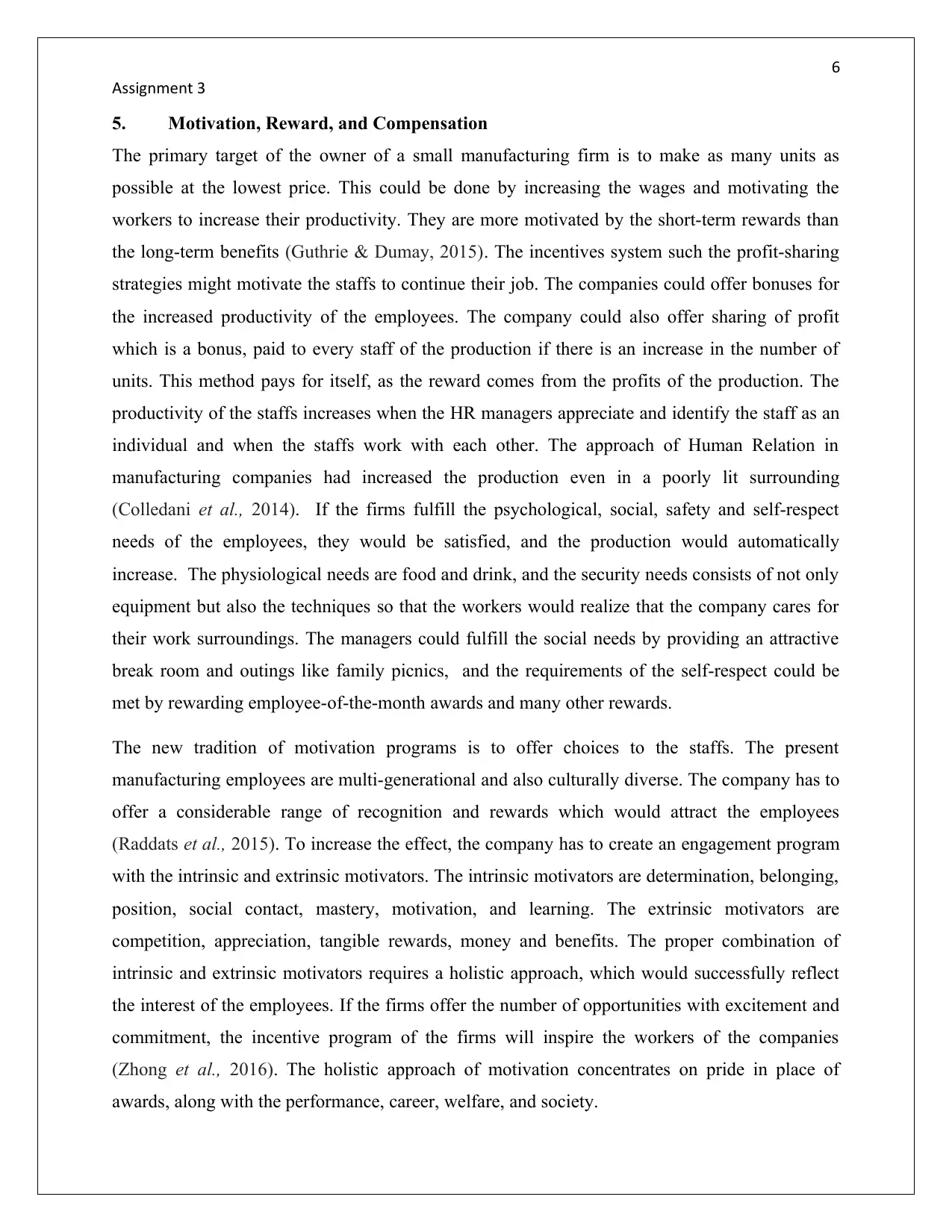
6
Assignment 3
5. Motivation, Reward, and Compensation
The primary target of the owner of a small manufacturing firm is to make as many units as
possible at the lowest price. This could be done by increasing the wages and motivating the
workers to increase their productivity. They are more motivated by the short-term rewards than
the long-term benefits (Guthrie & Dumay, 2015). The incentives system such the profit-sharing
strategies might motivate the staffs to continue their job. The companies could offer bonuses for
the increased productivity of the employees. The company could also offer sharing of profit
which is a bonus, paid to every staff of the production if there is an increase in the number of
units. This method pays for itself, as the reward comes from the profits of the production. The
productivity of the staffs increases when the HR managers appreciate and identify the staff as an
individual and when the staffs work with each other. The approach of Human Relation in
manufacturing companies had increased the production even in a poorly lit surrounding
(Colledani et al., 2014). If the firms fulfill the psychological, social, safety and self-respect
needs of the employees, they would be satisfied, and the production would automatically
increase. The physiological needs are food and drink, and the security needs consists of not only
equipment but also the techniques so that the workers would realize that the company cares for
their work surroundings. The managers could fulfill the social needs by providing an attractive
break room and outings like family picnics, and the requirements of the self-respect could be
met by rewarding employee-of-the-month awards and many other rewards.
The new tradition of motivation programs is to offer choices to the staffs. The present
manufacturing employees are multi-generational and also culturally diverse. The company has to
offer a considerable range of recognition and rewards which would attract the employees
(Raddats et al., 2015). To increase the effect, the company has to create an engagement program
with the intrinsic and extrinsic motivators. The intrinsic motivators are determination, belonging,
position, social contact, mastery, motivation, and learning. The extrinsic motivators are
competition, appreciation, tangible rewards, money and benefits. The proper combination of
intrinsic and extrinsic motivators requires a holistic approach, which would successfully reflect
the interest of the employees. If the firms offer the number of opportunities with excitement and
commitment, the incentive program of the firms will inspire the workers of the companies
(Zhong et al., 2016). The holistic approach of motivation concentrates on pride in place of
awards, along with the performance, career, welfare, and society.
Assignment 3
5. Motivation, Reward, and Compensation
The primary target of the owner of a small manufacturing firm is to make as many units as
possible at the lowest price. This could be done by increasing the wages and motivating the
workers to increase their productivity. They are more motivated by the short-term rewards than
the long-term benefits (Guthrie & Dumay, 2015). The incentives system such the profit-sharing
strategies might motivate the staffs to continue their job. The companies could offer bonuses for
the increased productivity of the employees. The company could also offer sharing of profit
which is a bonus, paid to every staff of the production if there is an increase in the number of
units. This method pays for itself, as the reward comes from the profits of the production. The
productivity of the staffs increases when the HR managers appreciate and identify the staff as an
individual and when the staffs work with each other. The approach of Human Relation in
manufacturing companies had increased the production even in a poorly lit surrounding
(Colledani et al., 2014). If the firms fulfill the psychological, social, safety and self-respect
needs of the employees, they would be satisfied, and the production would automatically
increase. The physiological needs are food and drink, and the security needs consists of not only
equipment but also the techniques so that the workers would realize that the company cares for
their work surroundings. The managers could fulfill the social needs by providing an attractive
break room and outings like family picnics, and the requirements of the self-respect could be
met by rewarding employee-of-the-month awards and many other rewards.
The new tradition of motivation programs is to offer choices to the staffs. The present
manufacturing employees are multi-generational and also culturally diverse. The company has to
offer a considerable range of recognition and rewards which would attract the employees
(Raddats et al., 2015). To increase the effect, the company has to create an engagement program
with the intrinsic and extrinsic motivators. The intrinsic motivators are determination, belonging,
position, social contact, mastery, motivation, and learning. The extrinsic motivators are
competition, appreciation, tangible rewards, money and benefits. The proper combination of
intrinsic and extrinsic motivators requires a holistic approach, which would successfully reflect
the interest of the employees. If the firms offer the number of opportunities with excitement and
commitment, the incentive program of the firms will inspire the workers of the companies
(Zhong et al., 2016). The holistic approach of motivation concentrates on pride in place of
awards, along with the performance, career, welfare, and society.
Paraphrase This Document
Need a fresh take? Get an instant paraphrase of this document with our AI Paraphraser
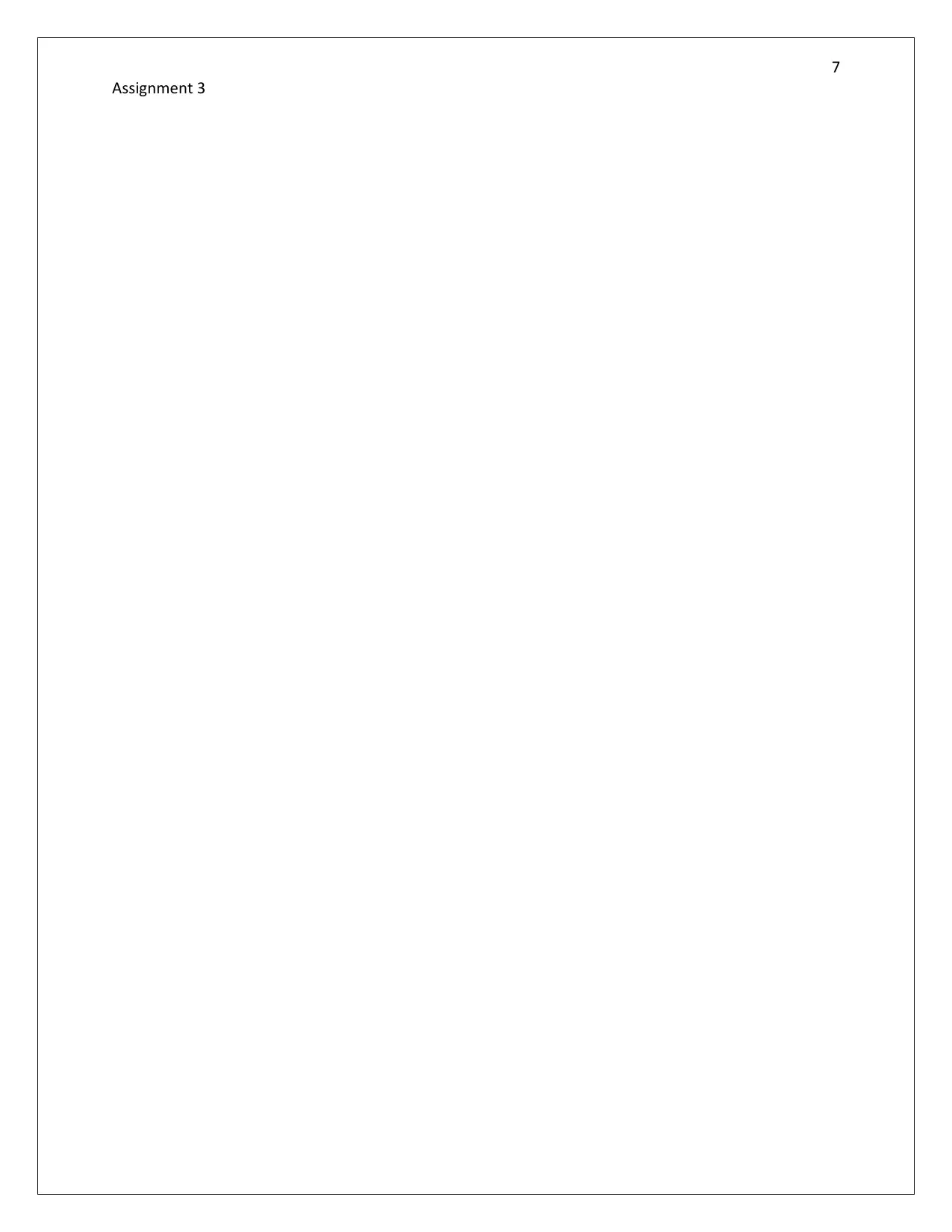
7
Assignment 3
Assignment 3
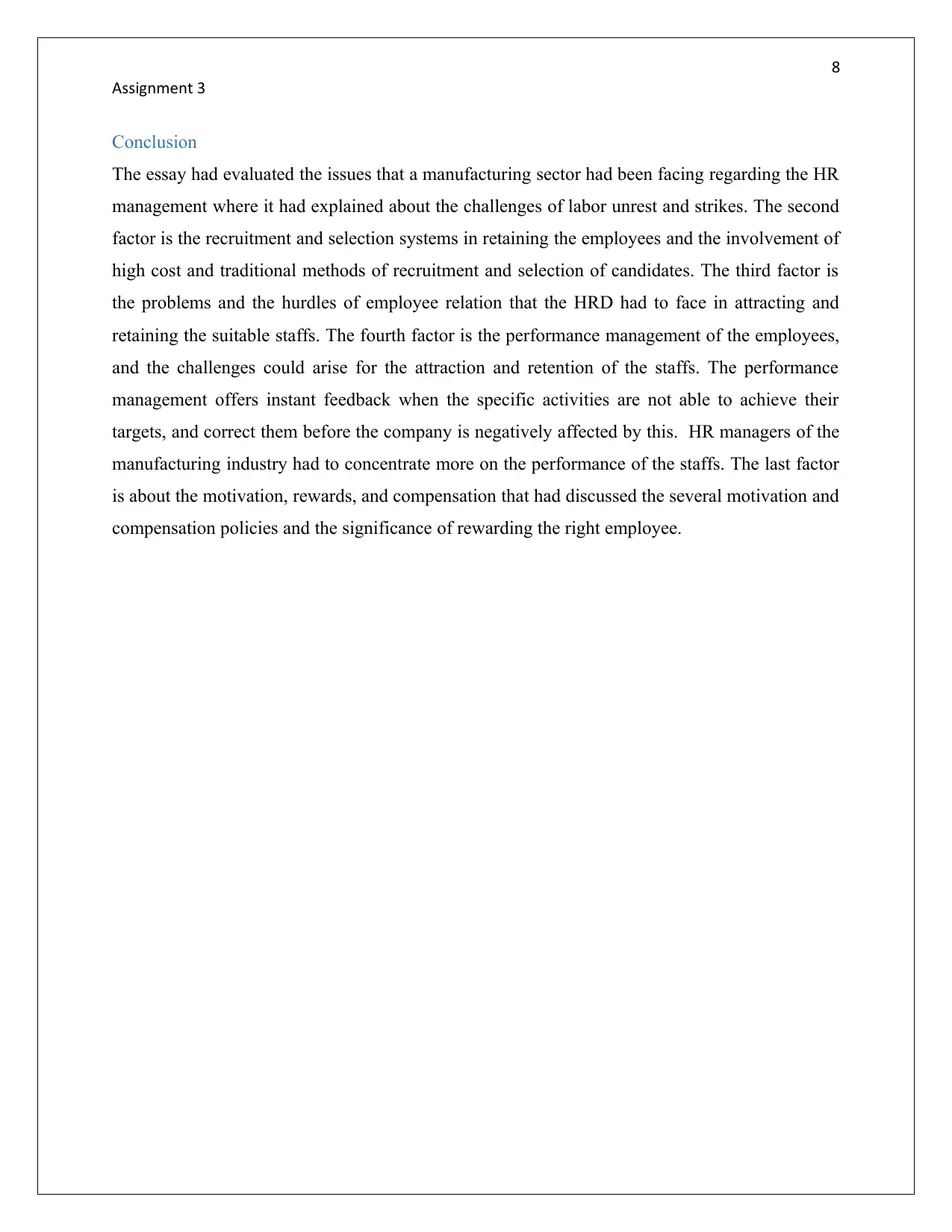
8
Assignment 3
Conclusion
The essay had evaluated the issues that a manufacturing sector had been facing regarding the HR
management where it had explained about the challenges of labor unrest and strikes. The second
factor is the recruitment and selection systems in retaining the employees and the involvement of
high cost and traditional methods of recruitment and selection of candidates. The third factor is
the problems and the hurdles of employee relation that the HRD had to face in attracting and
retaining the suitable staffs. The fourth factor is the performance management of the employees,
and the challenges could arise for the attraction and retention of the staffs. The performance
management offers instant feedback when the specific activities are not able to achieve their
targets, and correct them before the company is negatively affected by this. HR managers of the
manufacturing industry had to concentrate more on the performance of the staffs. The last factor
is about the motivation, rewards, and compensation that had discussed the several motivation and
compensation policies and the significance of rewarding the right employee.
Assignment 3
Conclusion
The essay had evaluated the issues that a manufacturing sector had been facing regarding the HR
management where it had explained about the challenges of labor unrest and strikes. The second
factor is the recruitment and selection systems in retaining the employees and the involvement of
high cost and traditional methods of recruitment and selection of candidates. The third factor is
the problems and the hurdles of employee relation that the HRD had to face in attracting and
retaining the suitable staffs. The fourth factor is the performance management of the employees,
and the challenges could arise for the attraction and retention of the staffs. The performance
management offers instant feedback when the specific activities are not able to achieve their
targets, and correct them before the company is negatively affected by this. HR managers of the
manufacturing industry had to concentrate more on the performance of the staffs. The last factor
is about the motivation, rewards, and compensation that had discussed the several motivation and
compensation policies and the significance of rewarding the right employee.
⊘ This is a preview!⊘
Do you want full access?
Subscribe today to unlock all pages.

Trusted by 1+ million students worldwide
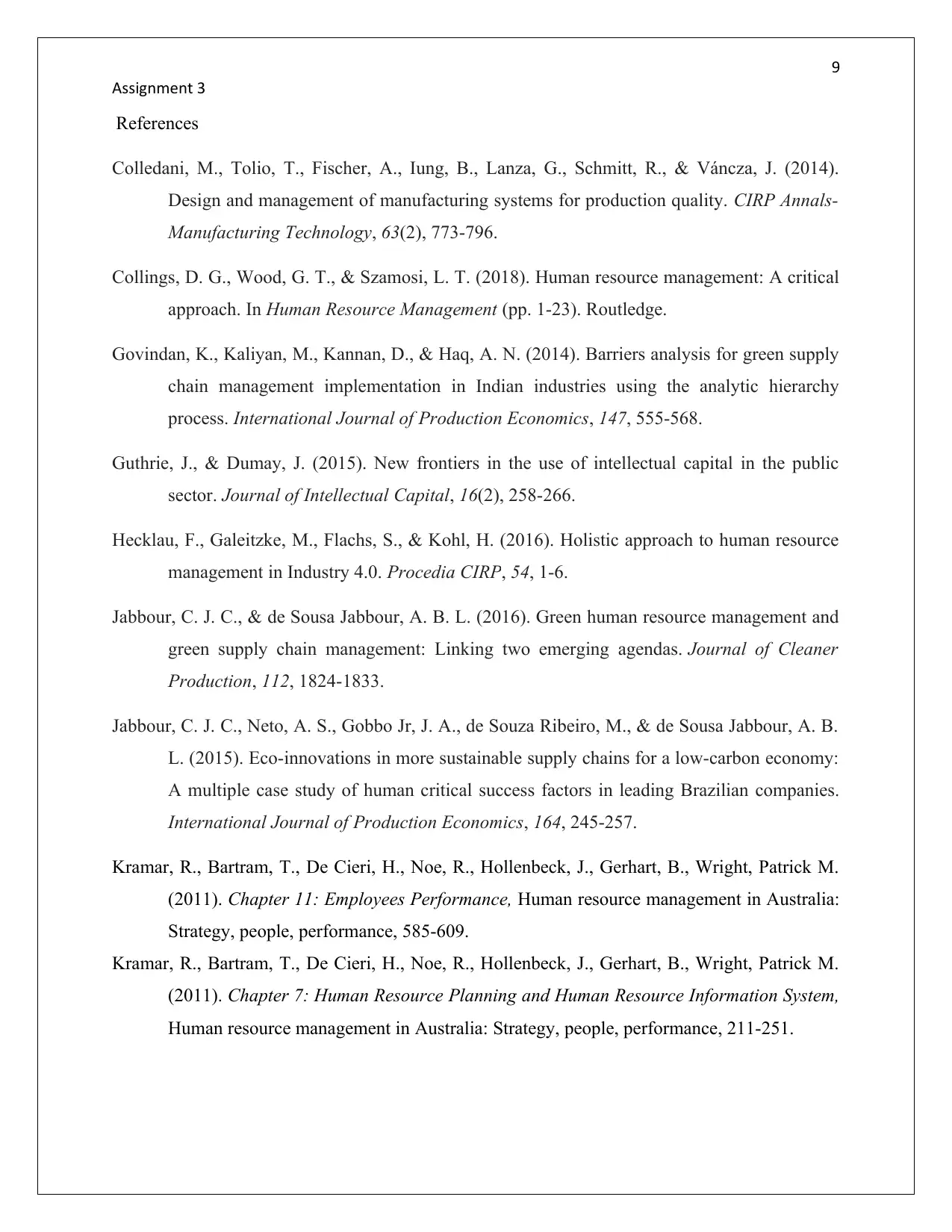
9
Assignment 3
References
Colledani, M., Tolio, T., Fischer, A., Iung, B., Lanza, G., Schmitt, R., & Váncza, J. (2014).
Design and management of manufacturing systems for production quality. CIRP Annals-
Manufacturing Technology, 63(2), 773-796.
Collings, D. G., Wood, G. T., & Szamosi, L. T. (2018). Human resource management: A critical
approach. In Human Resource Management (pp. 1-23). Routledge.
Govindan, K., Kaliyan, M., Kannan, D., & Haq, A. N. (2014). Barriers analysis for green supply
chain management implementation in Indian industries using the analytic hierarchy
process. International Journal of Production Economics, 147, 555-568.
Guthrie, J., & Dumay, J. (2015). New frontiers in the use of intellectual capital in the public
sector. Journal of Intellectual Capital, 16(2), 258-266.
Hecklau, F., Galeitzke, M., Flachs, S., & Kohl, H. (2016). Holistic approach to human resource
management in Industry 4.0. Procedia CIRP, 54, 1-6.
Jabbour, C. J. C., & de Sousa Jabbour, A. B. L. (2016). Green human resource management and
green supply chain management: Linking two emerging agendas. Journal of Cleaner
Production, 112, 1824-1833.
Jabbour, C. J. C., Neto, A. S., Gobbo Jr, J. A., de Souza Ribeiro, M., & de Sousa Jabbour, A. B.
L. (2015). Eco-innovations in more sustainable supply chains for a low-carbon economy:
A multiple case study of human critical success factors in leading Brazilian companies.
International Journal of Production Economics, 164, 245-257.
Kramar, R., Bartram, T., De Cieri, H., Noe, R., Hollenbeck, J., Gerhart, B., Wright, Patrick M.
(2011). Chapter 11: Employees Performance, Human resource management in Australia:
Strategy, people, performance, 585-609.
Kramar, R., Bartram, T., De Cieri, H., Noe, R., Hollenbeck, J., Gerhart, B., Wright, Patrick M.
(2011). Chapter 7: Human Resource Planning and Human Resource Information System,
Human resource management in Australia: Strategy, people, performance, 211-251.
Assignment 3
References
Colledani, M., Tolio, T., Fischer, A., Iung, B., Lanza, G., Schmitt, R., & Váncza, J. (2014).
Design and management of manufacturing systems for production quality. CIRP Annals-
Manufacturing Technology, 63(2), 773-796.
Collings, D. G., Wood, G. T., & Szamosi, L. T. (2018). Human resource management: A critical
approach. In Human Resource Management (pp. 1-23). Routledge.
Govindan, K., Kaliyan, M., Kannan, D., & Haq, A. N. (2014). Barriers analysis for green supply
chain management implementation in Indian industries using the analytic hierarchy
process. International Journal of Production Economics, 147, 555-568.
Guthrie, J., & Dumay, J. (2015). New frontiers in the use of intellectual capital in the public
sector. Journal of Intellectual Capital, 16(2), 258-266.
Hecklau, F., Galeitzke, M., Flachs, S., & Kohl, H. (2016). Holistic approach to human resource
management in Industry 4.0. Procedia CIRP, 54, 1-6.
Jabbour, C. J. C., & de Sousa Jabbour, A. B. L. (2016). Green human resource management and
green supply chain management: Linking two emerging agendas. Journal of Cleaner
Production, 112, 1824-1833.
Jabbour, C. J. C., Neto, A. S., Gobbo Jr, J. A., de Souza Ribeiro, M., & de Sousa Jabbour, A. B.
L. (2015). Eco-innovations in more sustainable supply chains for a low-carbon economy:
A multiple case study of human critical success factors in leading Brazilian companies.
International Journal of Production Economics, 164, 245-257.
Kramar, R., Bartram, T., De Cieri, H., Noe, R., Hollenbeck, J., Gerhart, B., Wright, Patrick M.
(2011). Chapter 11: Employees Performance, Human resource management in Australia:
Strategy, people, performance, 585-609.
Kramar, R., Bartram, T., De Cieri, H., Noe, R., Hollenbeck, J., Gerhart, B., Wright, Patrick M.
(2011). Chapter 7: Human Resource Planning and Human Resource Information System,
Human resource management in Australia: Strategy, people, performance, 211-251.
Paraphrase This Document
Need a fresh take? Get an instant paraphrase of this document with our AI Paraphraser
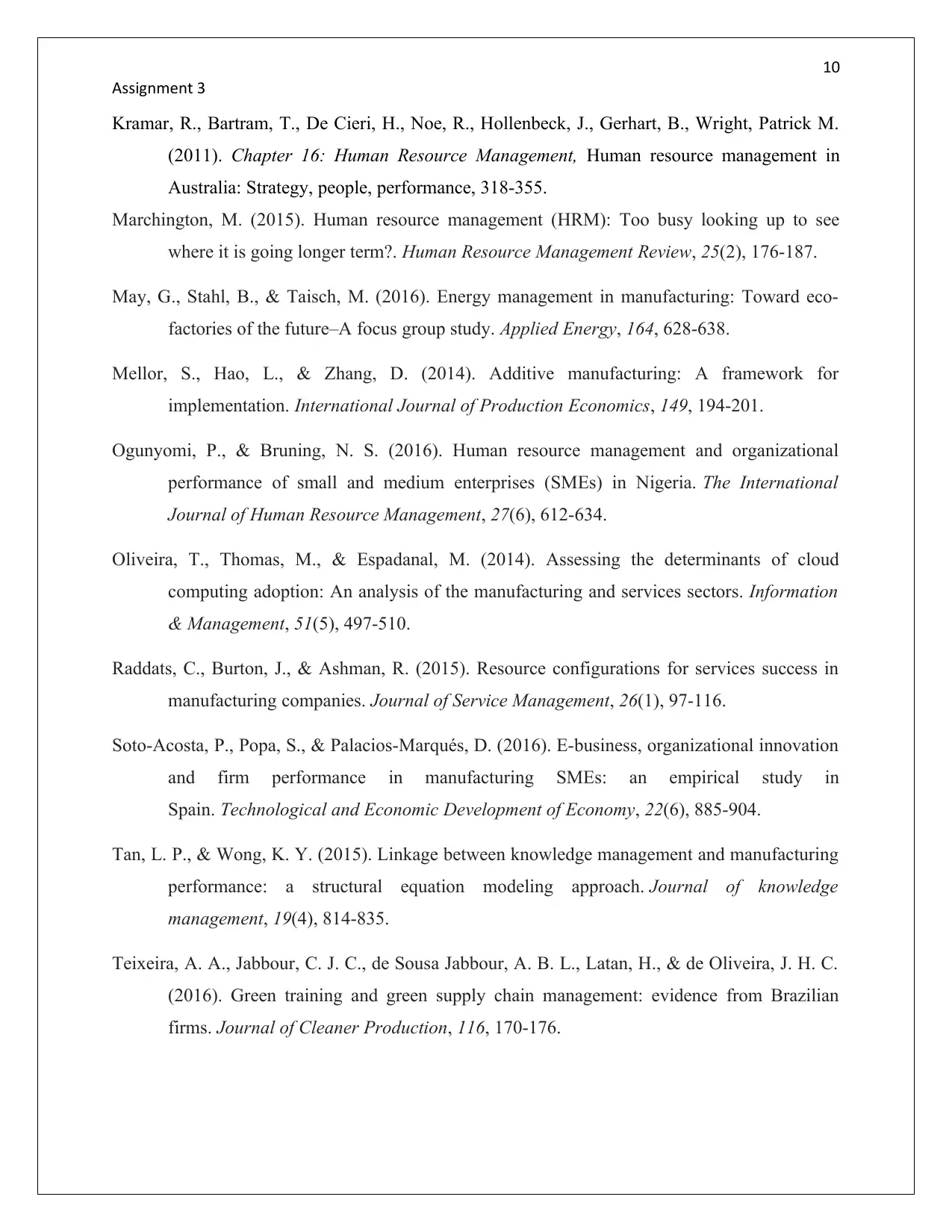
10
Assignment 3
Kramar, R., Bartram, T., De Cieri, H., Noe, R., Hollenbeck, J., Gerhart, B., Wright, Patrick M.
(2011). Chapter 16: Human Resource Management, Human resource management in
Australia: Strategy, people, performance, 318-355.
Marchington, M. (2015). Human resource management (HRM): Too busy looking up to see
where it is going longer term?. Human Resource Management Review, 25(2), 176-187.
May, G., Stahl, B., & Taisch, M. (2016). Energy management in manufacturing: Toward eco-
factories of the future–A focus group study. Applied Energy, 164, 628-638.
Mellor, S., Hao, L., & Zhang, D. (2014). Additive manufacturing: A framework for
implementation. International Journal of Production Economics, 149, 194-201.
Ogunyomi, P., & Bruning, N. S. (2016). Human resource management and organizational
performance of small and medium enterprises (SMEs) in Nigeria. The International
Journal of Human Resource Management, 27(6), 612-634.
Oliveira, T., Thomas, M., & Espadanal, M. (2014). Assessing the determinants of cloud
computing adoption: An analysis of the manufacturing and services sectors. Information
& Management, 51(5), 497-510.
Raddats, C., Burton, J., & Ashman, R. (2015). Resource configurations for services success in
manufacturing companies. Journal of Service Management, 26(1), 97-116.
Soto-Acosta, P., Popa, S., & Palacios-Marqués, D. (2016). E-business, organizational innovation
and firm performance in manufacturing SMEs: an empirical study in
Spain. Technological and Economic Development of Economy, 22(6), 885-904.
Tan, L. P., & Wong, K. Y. (2015). Linkage between knowledge management and manufacturing
performance: a structural equation modeling approach. Journal of knowledge
management, 19(4), 814-835.
Teixeira, A. A., Jabbour, C. J. C., de Sousa Jabbour, A. B. L., Latan, H., & de Oliveira, J. H. C.
(2016). Green training and green supply chain management: evidence from Brazilian
firms. Journal of Cleaner Production, 116, 170-176.
Assignment 3
Kramar, R., Bartram, T., De Cieri, H., Noe, R., Hollenbeck, J., Gerhart, B., Wright, Patrick M.
(2011). Chapter 16: Human Resource Management, Human resource management in
Australia: Strategy, people, performance, 318-355.
Marchington, M. (2015). Human resource management (HRM): Too busy looking up to see
where it is going longer term?. Human Resource Management Review, 25(2), 176-187.
May, G., Stahl, B., & Taisch, M. (2016). Energy management in manufacturing: Toward eco-
factories of the future–A focus group study. Applied Energy, 164, 628-638.
Mellor, S., Hao, L., & Zhang, D. (2014). Additive manufacturing: A framework for
implementation. International Journal of Production Economics, 149, 194-201.
Ogunyomi, P., & Bruning, N. S. (2016). Human resource management and organizational
performance of small and medium enterprises (SMEs) in Nigeria. The International
Journal of Human Resource Management, 27(6), 612-634.
Oliveira, T., Thomas, M., & Espadanal, M. (2014). Assessing the determinants of cloud
computing adoption: An analysis of the manufacturing and services sectors. Information
& Management, 51(5), 497-510.
Raddats, C., Burton, J., & Ashman, R. (2015). Resource configurations for services success in
manufacturing companies. Journal of Service Management, 26(1), 97-116.
Soto-Acosta, P., Popa, S., & Palacios-Marqués, D. (2016). E-business, organizational innovation
and firm performance in manufacturing SMEs: an empirical study in
Spain. Technological and Economic Development of Economy, 22(6), 885-904.
Tan, L. P., & Wong, K. Y. (2015). Linkage between knowledge management and manufacturing
performance: a structural equation modeling approach. Journal of knowledge
management, 19(4), 814-835.
Teixeira, A. A., Jabbour, C. J. C., de Sousa Jabbour, A. B. L., Latan, H., & de Oliveira, J. H. C.
(2016). Green training and green supply chain management: evidence from Brazilian
firms. Journal of Cleaner Production, 116, 170-176.
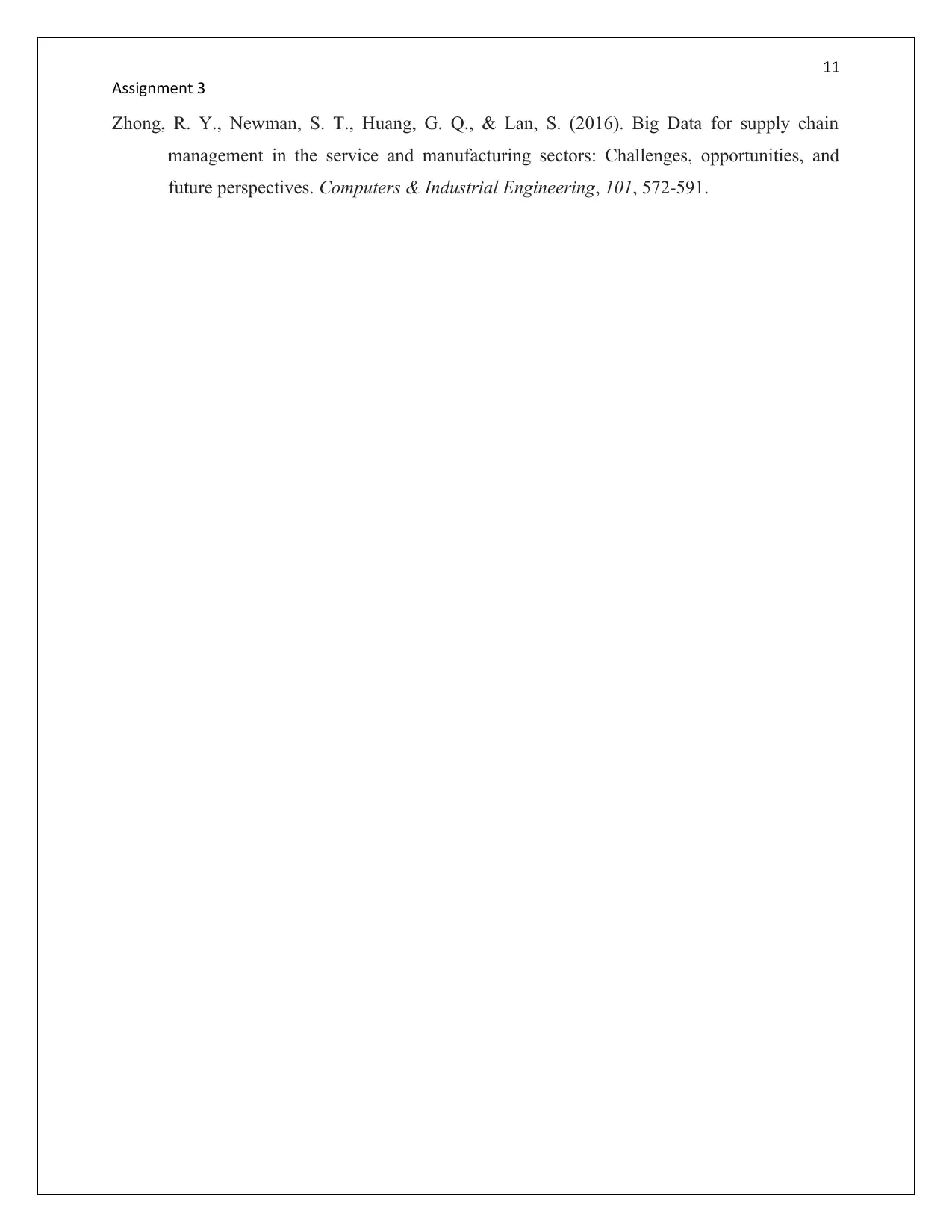
11
Assignment 3
Zhong, R. Y., Newman, S. T., Huang, G. Q., & Lan, S. (2016). Big Data for supply chain
management in the service and manufacturing sectors: Challenges, opportunities, and
future perspectives. Computers & Industrial Engineering, 101, 572-591.
Assignment 3
Zhong, R. Y., Newman, S. T., Huang, G. Q., & Lan, S. (2016). Big Data for supply chain
management in the service and manufacturing sectors: Challenges, opportunities, and
future perspectives. Computers & Industrial Engineering, 101, 572-591.
⊘ This is a preview!⊘
Do you want full access?
Subscribe today to unlock all pages.

Trusted by 1+ million students worldwide
1 out of 12
Related Documents
Your All-in-One AI-Powered Toolkit for Academic Success.
+13062052269
info@desklib.com
Available 24*7 on WhatsApp / Email
![[object Object]](/_next/static/media/star-bottom.7253800d.svg)
Unlock your academic potential
Copyright © 2020–2025 A2Z Services. All Rights Reserved. Developed and managed by ZUCOL.




